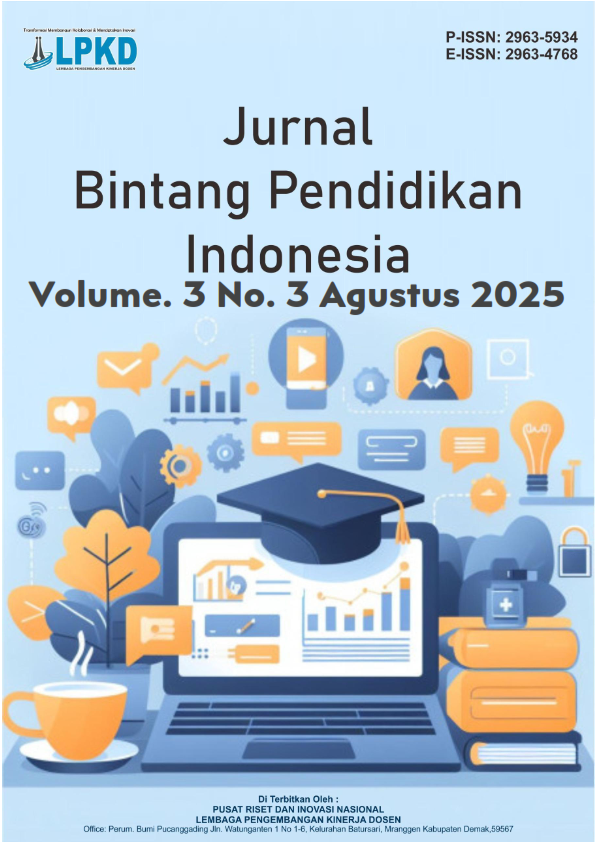Pemanfaatan Alat Peraga Benda Konkret untuk Meningkatkan Hasil Belajar Matematika di Sekolah Dasar Islam Terpadu Asy-Syifa' Bayung Lencir
DOI:
https://doi.org/10.55606/jubpi.v3i2.3839Keywords:
props, Learning, outcomesAbstract
This research is motivated by the results of initial observations in class II of SD IT Asy-Syifa' Bayung Lencir which experienced problems in the form of low student learning outcomes in mathematics subjects which also became the main motivation in this research, so that it is necessary to use learning tools or media that can increase student involvement and understanding of the material being taught. The purpose of the study was to describe the application of the concrete object teaching aid media learning method to improve the learning outcomes of class II students at the Asy-Syifa' Bayung Lencir Integrated Islamic Elementary School. The type of research is Classroom Action Research (CAR) with the aim of determining the increase in student learning outcomes by using concrete object learning media. The results of the study showed that the application of the concrete object teaching aid media learning method can improve the learning outcomes of class II students at the Asy-Syifa' Bayung Lencir Integrated Islamic Elementary School. The learning outcomes of class II students at the Asy-Syifa Bayung Lencir Integrated Islamic Elementary School in cycle I were 72.29 with a percentage of completion of 54.17%. These results are still below the completion standard, which is> 75% and the learning objectives have not been achieved. Furthermore, the average mathematics learning outcomes of grade II students at SD Islam Terpadu Asy-Syifa Bayung Lencir in cycle II were 79.79 with a completion percentage of 87.50%. These results are above the completion standard, which is > 75% and the learning objectives have been achieved.
References
Alpian. (2019). Pendidikan sebagai investasi masa depan. Jakarta: PT Gramedia.
Arsyad, A. (2016). Media pembelajaran. Jakarta: Rajawali Pers.
Depdiknas. (2003). Undang-Undang Sistem Pendidikan Nasional No. 20 Tahun 2003. Jakarta: Departemen Pendidikan Nasional.
Hamalik, O. (2019). Pendidikan dan pembangunan nasional. Bandung: PT Remaja Rosdakarya.
Jalal, dkk. (2024). Media pembelajaran dalam meningkatkan hasil belajar siswa. Yogyakarta: Deepublish.
Lewin, K. (1946). Action research and minority problems. Journal of Social Issues, 2(4), 34-46.
Piaget, J. (1952). The origins of intelligence in children. New York: Norton.
Slameto. (2013). Belajar dan faktor-faktor yang mempengaruhinya. Jakarta: Rineka Cipta.
Suarjana, I. M. (2017). Matematika dalam kehidupan sehari-hari. Denpasar: Udayana Press.
Sudjana, N. (2010). Metode statistika. Bandung: Tarsito.
Suherman, E. (2012). Strategi pembelajaran matematika. Bandung: UPI Press.
Sulaiman. (2020). Media pembelajaran konkret dalam meningkatkan pemahaman siswa. Jakarta: RajaGrafindo Persada.
Sungkono. (2013). Penerapan media benda konkrit dalam pembelajaran. Surabaya: Unesa Press.
Susanto, A. (2017). Pendidikan karakter dalam pembelajaran. Jakarta: Bumi Aksara.
Tumangkek, J. (2018). Penggunaan media konkret dalam pembelajaran anak usia dini. Bandung: Alfabeta.
Downloads
Published
How to Cite
Issue
Section
License
Copyright (c) 2025 Sri Handayani, Arif Wiratama

This work is licensed under a Creative Commons Attribution-ShareAlike 4.0 International License.








